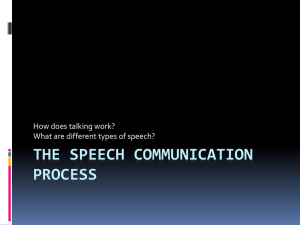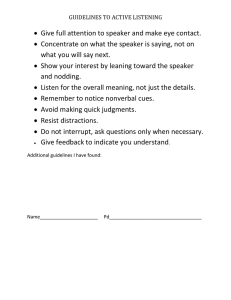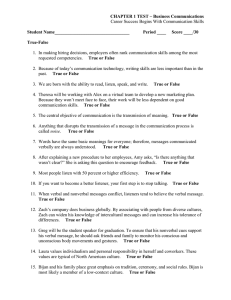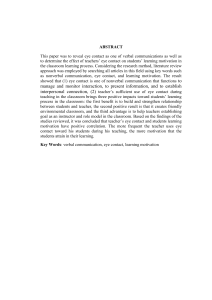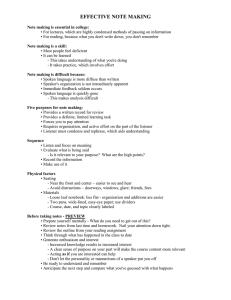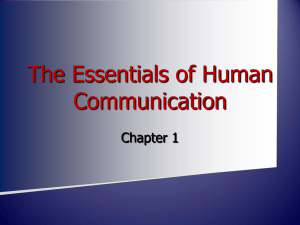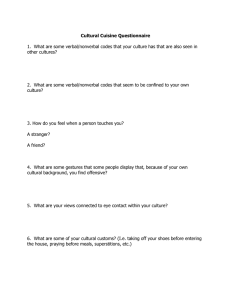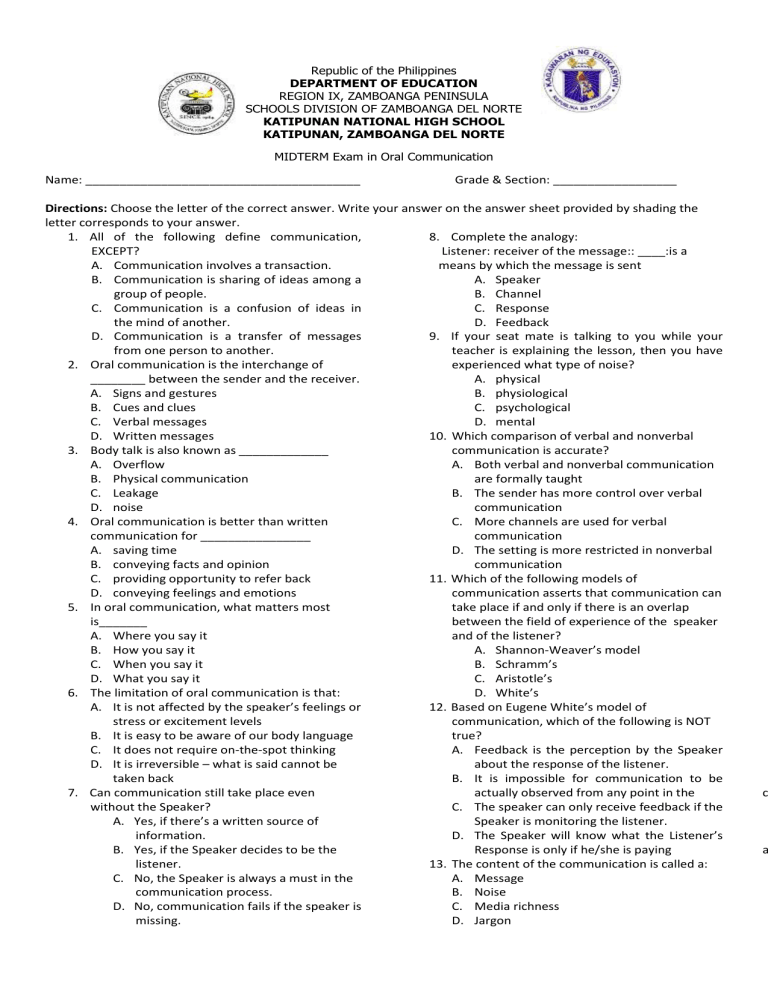
Republic of the Philippines DEPARTMENT OF EDUCATION REGION IX, ZAMBOANGA PENINSULA SCHOOLS DIVISION OF ZAMBOANGA DEL NORTE KATIPUNAN NATIONAL HIGH SCHOOL KATIPUNAN, ZAMBOANGA DEL NORTE MIDTERM Exam in Oral Communication Name: ________________________________________ Grade & Section: __________________ Directions: Choose the letter of the correct answer. Write your answer on the answer sheet provided by shading the letter corresponds to your answer. 1. All of the following define communication, 8. Complete the analogy: EXCEPT? Listener: receiver of the message:: ____:is a A. Communication involves a transaction. means by which the message is sent B. Communication is sharing of ideas among a A. Speaker group of people. B. Channel C. Communication is a confusion of ideas in C. Response the mind of another. D. Feedback D. Communication is a transfer of messages 9. If your seat mate is talking to you while your from one person to another. teacher is explaining the lesson, then you have 2. Oral communication is the interchange of experienced what type of noise? ________ between the sender and the receiver. A. physical A. Signs and gestures B. physiological B. Cues and clues C. psychological C. Verbal messages D. mental D. Written messages 10. Which comparison of verbal and nonverbal 3. Body talk is also known as _____________ communication is accurate? A. Overflow A. Both verbal and nonverbal communication B. Physical communication are formally taught C. Leakage B. The sender has more control over verbal D. noise communication 4. Oral communication is better than written C. More channels are used for verbal communication for ________________ communication A. saving time D. The setting is more restricted in nonverbal B. conveying facts and opinion communication C. providing opportunity to refer back 11. Which of the following models of D. conveying feelings and emotions communication asserts that communication can 5. In oral communication, what matters most take place if and only if there is an overlap is_______ between the field of experience of the speaker A. Where you say it and of the listener? B. How you say it A. Shannon-Weaver’s model C. When you say it B. Schramm’s D. What you say it C. Aristotle’s 6. The limitation of oral communication is that: D. White’s A. It is not affected by the speaker’s feelings or 12. Based on Eugene White’s model of stress or excitement levels communication, which of the following is NOT B. It is easy to be aware of our body language true? C. It does not require on-the-spot thinking A. Feedback is the perception by the Speaker D. It is irreversible – what is said cannot be about the response of the listener. taken back B. It is impossible for communication to be 7. Can communication still take place even actually observed from any point in the without the Speaker? C. The speaker can only receive feedback if the A. Yes, if there’s a written source of Speaker is monitoring the listener. information. D. The Speaker will know what the Listener’s B. Yes, if the Speaker decides to be the Response is only if he/she is paying listener. 13. The content of the communication is called a: C. No, the Speaker is always a must in the A. Message communication process. B. Noise D. No, communication fails if the speaker is C. Media richness missing. D. Jargon c a 14. To convert a message into groups of words, symbols, gestures, or sounds that present ideas or concept is called ________. A. Encoding B. Feedback C. Noise D. Media richness 15. Any communication that conveys a message consisting of words is called: A. Verbal communication B. Oral communication C. Written communication D. Nonverbal communication 16. Due to insufficiency of available classrooms, the covered court of Katipunan NHS is now being used to hold classes temporarily. This real scenario is an example of which element of communication? A. Message B. Physical location of communicative situation C. Channel D. Psychological setting of communicative situation 17. A politician says that he is a man of people, but many observe that he refuses to shake hands with the poor. What dimension of communication is violated in this case? A. Verbal/Non-Verbal B. Oral/Written C. Formal/Informal D. Intentional/Unintentional 18. A certain look or gaze is an example of: A. Verbal communication B. Oral communication C. Written communication D. Nonverbal communication 19. It is the process by which the receiver interprets the symbols used y the source of the message by converting them into concepts and ideas. A. Decoding B. Listing C. Encoding D. Feedback 20. The _____________ is the individual or group that develops the message to be communicated to internal and external parties. A. Source B. Encoder C. Decoder D. Jargon 21. Noise is NOT a problem at which stage of the communication? A. Source B. Receiver C. Decoding D. None of the above (noise is a problem at all stages) 22. It shows how time is viewed differently in various countries. A. Chronemics B. Haptics C. Proxemics D. Gestures 23. The use of space provides us with ideas about how close or how far people are from the center of power or where a person is in the social ladder. A. Chronemics B. Haptics C. Proxemics D. Gestures 24. It is a type of nonverbal communication that assists the listener in understanding the message better which serves as the listener’s gauge as to whether the speaker treats the listener with affective or with contempt. A. Posture B. Facial expression C. Gesture D. Chronemics 25. These are deliberate movement and signals to communicate meaning without words. A. Eye gaze B. Gesture C. Facial expression D. Appearance 26. These are the means by which the message is sent. A. Channels B. Feedback C. Response D. noise 27. It is a communication through touch and is considered as one of the most powerful of the types of nonverbal communication. A. Haptics B. Gesture C. Chronemics D. Proxemics 28. He made the cyclical model that tells us that communication is circular and continuous, without beginning or end. A. Wilbur Schramm B. Eugene White C. Aristotle D. Claude Shannon 29. This model gave us the concept of noise and this is often called the TELEPHONE MODEL. A. Aristotelian Model of Communication B. Schramm Model of Communication C. Shannon- Weaver Model of Communication D. Eugene White Model of Communication 30. He was considered the father of Mass Communication. A. Wilbur Schramm B. Eugene White C. Aristotle D. Claude Shannon 31. This involves only two participants exchanging thoughts, ideas, opinions, and information. a. Intrapersonal communication b. Dyadic communication c. Public communication d. Small group communication 32. When talking to one’s self (Intrapersonal), which of the following is most used? a. Skill at remembering b. Capability to analyze c. Ability to summarize d. Awareness of the topic 33. When communicating with other person (Dyad), which speech style can be used? a. Intimate – uses private vocabulary and shares meaning due to long relationship b. Casual – used among friends because there is no need for background information c. Formal – only for imparting information: well- organized and correct in grammar and diction d. Frozen – style whose quality is static, ritualistic, and may even be archaic 34. When making and delivering speech, which speech style works best? a. Intimate b. Casual c. Formal d. Frozen 35. Communication break down or miscommunication is brought about by the lack of awareness of the ________. a. dimensions of communication b. elements of communication c. nonverbal communication d. models of communication There is always a reason why people communicate. For numbers 37 – 50, choose what is being used in the following instances of communication from the given five functions of communication. A. REGULATION/ CONTROL B. SOCIAL INTERACTION C. MOTIVATION D. INFORMATION E. EMOTIONAL EPRESSION F. EMOTIONAL EXPRESSION 36. The father looks sharply at his children who are quarrelling. 37. The boys calling out to a friend to come over and joined them. 38. A candidate for Brgy. Councilor conducts a house-to-house campaign for election. 39. The school dentist tells the kindergarten class on how to brush one’s teeth properly. 40. Kuya Kim provides information about the weather update. 41. People sympathizing with the bereaved family. 42. Friends are talking with each other and exchanging ideas. 43. Talking with the family during dinner. 44. A customer plead for a price cut or discount of his purchased goods 45. The police officer warns the people not to smoke in any public places. 46. A friend hugs you when you are down and troubled. 47. The girls are discussing what happened at the party they all attended last night. 48. The doctor is giving instructions to the patient in taking his medicine. 49. The mother hugs the crying baby. 50. The father tells his children not to go out with their friends “The most important thing in communication is to hear what isn’t being said”. - Peter F. Drucker
